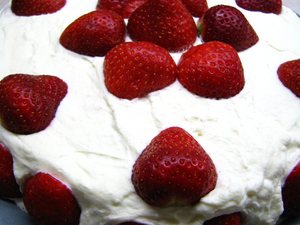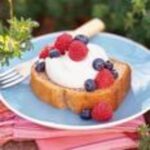Let’s face it; America is having a love affair with bad food. And we love nothing more than our sweets. Walk down to any corner store and you will find shelves packed with brownies, cookies, cakes, doughnuts and other sweets. Look at the ingredients list, and you will see three common offenders; white sugar, white flour and hydrogenated shortening. These three ingredients, consumed in large quantities over a long period of time, can spell a death sentence.
The good news is that it doesn’t have to be this way. We can have our cake and eat it, too, so to speak. But in order to do that, we must make a few healthy adjustments to what we consider a “normal” recipe.
Recipes for baked goods are actually very flexible. They can withstand a considerable amount of toying, alteration and experimentation. I have subjected a good number of recipes to a torture test to see how much alteration they could handle to make them healthier. Most of them have turned out very well.
The trick to making healthy baked goods is proper ingredient substitution.
Replacing White Flour
The first thing you have to do is get the white flour out of your pantry, and replace it with a high quality, healthy 100% whole wheat flour. I recommend Hodgson Mill, King Arthur and Whole Foods’ bulk 100% whole wheat flour. Never use low quality whole wheat flour such as Gold Medal. No matter how much they promote their products, they simply don’t measure up to the competition, and are not worth the money you save.
Regular 100% whole wheat flour will work in most baked goods recipes. However, if you find that the texture of the finished product is less than ideal, you can use 100% whole wheat pastry flour. Whole wheat pastry flour is lower in wheat gluten, which is the protein in wheat, and thus produces a smoother product when making baked goods other than yeast bread.
Simply substitute this whole wheat flour one to one for the white flour. Don’t cut the whole wheat flour with white flour, either. White flour is totally unnecessary in baking. I haven’t had it in my kitchen in years. In fact, I don’t even use it for rolling dough. I simply sprinkle a little whole wheat flour on my counter, and voila! my baked goods don’t stick. It works every bit as well as white flour. In fact, I find it often works better, because of its rougher texture.
The next trick is to try multi-grain. Be sure that the other grains you use are whole. For example, corn meal and oatmeal are always whole grain, whereas other grains such as spelt and rye are often sold in white form. Also keep in mind that corn and oats, being low in gluten, and different in texture tend to bake up differently than wheat. At first, keep them to a minimum in the recipe, and use recipes that call for corn meal and oatmeal as a guide. You can also combine two similar recipes to come up with a desired result. For example, if you want to put oats in your chocolate chip cookie recipe, refer to an oatmeal cookie recipe to find the ideal ratio of oatmeal to wheat flour for baking. Then simply replace the flour in that recipe with 100% whole wheat and see how it turns out. In my experience, it always turns out well.
Replacing White Sugar
The next and probably the most crucial tactic is to find a healthy substitute for the white sugar in your baked recipes. Fortunately, there are many excellent alternatives available, all of which are natural and highly nutritious.
One of the best healthy substitutions is called sucanat. Its name is a contraction of sugar cane natural. Sucanat is made from evaporated whole cane juice, and is available in most health food stores, such as Whole Foods. It quite literally contains the whole sugar of the sugar cane, so it is very dark brown. I recommend this over brown sugar, which is merely white sugar with a trivial amount of molasses poured over it. It really isn’t much more healthy than white sugar, and it still suffers from the “broken sugar” effect; that is, it contains a very high proportion of the sweet part of the sugar, but proportionately few of the vitamins, minerals and other nutrients and antioxidants which are naturally contained within the whole sugar.
However, keep in mind that baking with straight sucanat is rather difficult. Sucanat recipes can also be hard to find. In most baked recipes, sucanat cannot replace white sugar one to one without a dramatic change in taste, texture and browning. So for that reason you should mix the sucanat with white, turbinado or other dry sugar, and use this mixture with a one to one ratio to replace the white sugar in the recipe. The ratio of this mixture is flexible. You can use equal parts sucanat and white sugar, or one part sucanat to two or even three parts white sugar. Try different mixtures and make notes as to what works best.
If you use this method I strongly recommend reducing the sugar in the recipe. The sugar in most baked goods recipes can be reduced by as much as one third, with no replacement, without adversely affecting the taste or texture. This requires some experimentation, but I have tried it in a number of recipes, and have had smashing successes many times over. Since reducing sugar can cause recipes to bake up drier, you might want to consider using part liquid sugar, or slightly increasing the liquid in the recipe. You can also replace up to one quarter of the sugar in any baked recipe with powdered milk.
Other natural, healthy sugar substitutes include honey, fruit juice concentrates, turbinado sugar, pureed fruit, maple syrup, molasses and stevia. I do not recommend artificial sugar substitutes such as saccharin (Sweet ‘n Low), aspartame (Nutrasweet) or sucralose (Splenda). First of all, you can’t bake with aspartame because it breaks down under heat. Sucralose and saccharin, even though you can bake with them, act as toxins within the body. Sucralose has not been tested extensively in humans, and it’s difficult to say what negative health effects it could have on the body. I fully support the moderate use of sucralose, such as having the occasional diet soda sweetened with Splenda. However, I simply feel that baking with artificial sweeteners could lead to consuming them in excess. It generally doesn’t produce a quality baked product, and you’ll probably end up mixing it with sugar anyway to get the taste and texture you desire. And that leaves you right back where you started. Except that now, in addition to lots of sugar, insulin and calories, your body now also has to cope with toxic, artificial chemicals.
Certain adjustments need to be made when substituting a liquid sugar for a dry sugar, and vice versa. Generally, when using a liquid sugar for a dry sugar, you must reduce the liquid content of the baked good. This can be difficult in recipes such as brownies and cookies which don’t call for any additional liquid.
For example, when replacing sugar with maple syrup, you should use 3/4 cup of maple syrup, plus 1/4 teaspoon baking soda, and reduce the liquid in the recipe by three tablespoons. If your recipe has no other liquid in it, you can substitute maple sugar, which is dry. Be sure to use real maple syrup, not prepared pancake syrup which is made from corn syrup or sugar.
When substituting with molasses, use 1 1/3 cup of molasses, plus one teaspoon of baking soda per cup of sugar. Reduce a liquid in the recipe by 1/3 cup, and lower the oven temperature by 25 degrees. Never replace more than half the sugar in recipe with molasses, as it imparts a very strong flavor.
Substitute 3/4 honey plus 1/4 teaspoon baking soda for each cup of sugar in a recipe, then reduce the liquid in the recipe by 1/4 cup. (Warning: never feed honey to infants under the age of one year, as it could cause botulism in this age group.)
Pureed fruit can often be substituted one to one for sugar in a recipe. Keep in mind that the result will be moister, and dramatically less sweet. You can cope with this problem by also using pureed raisins, currants, dates, or other very sweet, dried fruit. Be sure to add a small amount of water to the dried fruit while pureeing for the best result. You can also use the pureed fruit to replace only part of the sugar in the recipe, and use a dry sugar substitute for the rest of the sugar.
Never use granulated fructose or liquid corn syrup to replace sugar. It’s just as sweet, and just as devoid of nutrients as table sugar.
Replacing Hydrogenated Fat
You can also use pureed fruit to replace the fat in a recipe. Using this healthy substitution in combination with dry sugar substitutes such as maple sugar and turbinado sugar can result in a very satisfying, high nutrient, moist and delicious low-fat baked product. When using pureed fruit to substitute for fat, you may reduce the sugar in the recipe by up to one third without ill effect.
Shortening and butter can be replaced one to one with with liquid oil. However, keep in mind that liquid oil produces a very different texture than shortening or butter, especially in cookies. Healthy cookies made with liquid oil tend to bake up soft and chewy rather than crispy, especially when using whole wheat flour and reducing sugar or using sugar substitutes. However, don’t let that stop you from trying this substitution. Healthy chewy cookies are very delicious, and you will quickly develop a taste for them. They’re almost like miniature cakes. They’re also a major kid pleaser. You don’t have to feel bad about feeding these healthy cookies to kids as you would their unhealthy counterparts. They also don’t have to be controlled as much. For example, you can let your kids go to town on healthy cookies made from nothing but peanut butter, oats, whole wheat and bananas, whereas you’d have to be very strict with cookies made from unhealthy ingredients.
Eliminating Aluminum
Another important substitution for healthy baked goods is a quality aluminum-free baking powder. This is one item people tend to miss when thinking about healthy baking. Aluminum has been associated with Alzheimer’s disease, Parkinson’s disease and lateral sclerosis (Lou Gehrig’s disease).
You may also want to consider using stainless steel cookware, and avoiding the use of aluminum foil during cooking. Also municipal water treatment plants use aluminum to reduce the bacteria in our water supply. It’s very simple to get a water filtration system to filter it out. Water filters remove other toxins like chlorine and lead, so they’re well worth the investment. I use a Brita pitcher to filter water for cooking and drinking.
While the connection between aluminum and these diseases is far from certain, there’s no harm in avoiding it. In my experience, I find it’s best to be on the safe side.
Eggs
Many people substitute egg whites for whole eggs. However, throwing out the yolk of an egg is wasteful. You’re not just throwing out fat and calories. Your throwing out nutrition.
Egg yolks are nutritional powerhouses. They contain significant amounts of important nutrients such as protein, calcium, magnesium, iron, phosphorus, potassium, zinc, copper, manganese, selenium, thiamin, riboflavin, pantothenic acid, vitamin B6, folate, and many more. In fact, most of the nutrients in an egg are contained within the yolk, and many nutrients are contained exclusively in the yolk, such as vitamins A, E, D, K, Omega 3 and 6 fatty acids, and carotene. If you’re a vegetarian, like I am, eggs are an important source of vitamin B12, which is difficult to impossible to get from plant foods. The only plant source of vitamin B12 is nutritional yeast, which is expensive and tastes terrible.
So if you’re looking to cut out fat and cholesterol, you can reduce another fat by a tablespoon or more, perhaps substituting with pureed fruit. Eliminate shortening and butter from you diet. But when you’re baking, go ahead and use the whole egg. The reduction in fat and cholesterol you get from dumping that yolk down the drain simply isn’t worth the nutrients you’re losing.
Also, consider using cage free eggs from vegetarian fed hens. These eggs are likely going to be higher in all essential nutrients, and anyway, it’s for a good cause. Also, eggs from pastured hens have been shown to be higher in nutrients than conventionally produced eggs.
High Nutrient vs. Low Calorie
Most people define the health of a food based on what it doesn’t contain. Just say low fat, low salt, low calorie, or low sugar to a person, and they automatically interpret the corresponding food as “healthy,” even if it is also devoid of all other nutrients.
Increasing our nutrient intake is every bit as important as reducing calories. Avoiding empty calories is of the essence. So when you’re baking sweets, think about the nutrient content of the ingredients you’re using. If they contain little or nothing in the way of vitamins, minerals, antioxidants, and essential fatty acids, consider replacing them with another ingredient with a higher nutrient content.
For example, most chocolate chip cookie recipes call for a full cup of chocolate chips. What most people don’t realize is that you can reduce this to one quarter cup without harming the taste of the recipe in the slightest. In fact, chocolate chip cookies are actually more palatable with fewer chips.
Adding some healthy nuts to the recipe is a good trade-off. For example, you could add a quarter to a half cup of chopped English walnuts or pecans to enhance the flavor and texture of the recipe. Even though you won’t enjoy a reduction in calories, the finished product will contain important and healthful fats, and you’ll avoid the insulin overdrive that can come from using too much sugar in a recipe.
Never Eat Sweets on an Empty Stomach
There is more than one reason not to eat dessert first. Eating sugar on an empty stomach causes an extreme spike in blood sugar levels, causing an increase in insulin levels. Then it causes a corresponding blood sugar crash. This gets you caught in the insulin trap. High insulin and low blood sugar levels cause you to crave more sugar, which cause you to eat more sugar. So if you’re planning to eat sweet foods, it’s best to make sure that you’ve got some other nutrients first in order to cushion your metabolism.
Make sure that you take a healthy meal which contains protein, unsaturated fat, whole grains, fruits and vegetables before indulging in sweet desserts. Then don’t go overboard. Keep the dessert small.
Eat Less
This is by far the one tactic that most people miss, and yet it is the most important. Sweets and baked goods have an important role to play in our lives, but it’s also important that they don’t step outside of that role. Keeping our intake of sugary foods to a minimum is essential if we are to maintain proper health and a normal weight.
So use whatever tactics are necessary to reduce your intake of sweets, and that of your children. Make smaller cookies, and cut brownies and cakes in smaller pieces. Keep sweets stored in an inconvenient place, such as a locked cookie jar or in the freezer. Don’t be afraid to eat only a part of a cookie or piece of cake, and leave the rest. You don’t have to eat the whole thing, just because it was placed in front of you.
In restaurants, never order a whole dessert for yourself. Instead, order just one and split it with as many people as possible. Or better yet, skip dessert at the restaurant and go home for dessert. Something simple like fresh strawberries with a little whipped cream on top will save both calories and sugar, and provides an antioxidant kick while still satisfying the sweet tooth.
Using all of these methods in combination will help you to increase your nutrient intake, and reduce your intake of unhealthy simple carbohydrates. You will experience greater overall health and longevity, and you’ll look better and feel better in the long run.
Uncredited, “Sugars.” The Cook’s Thesaurus. URL: (http://www.foodsubs.com/Sweeten.html)
Melissa Knopper, “Heavy metal? Exploring the aluminum/Alzheimer’s link.” LookSmart. URL: (http://findarticles.com/p/articles/mi_m1594/is_1_16/ai_n8686452/pg_1)
Uncredited, “The Incredible, Edible Egg Yolk.” Cholesterol-and-Health.com. URL: (http://www.cholesterol-and-health.com/Egg_Yolk.html)
Uncredited, “Hypoglycemia.” EnzymeStuff. URL: (http://www.enzymestuff.com/hypoglycemia.htm)






